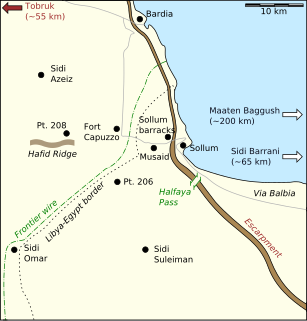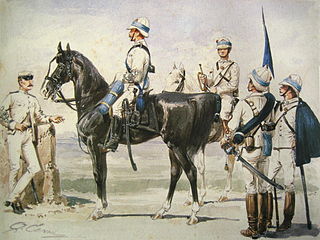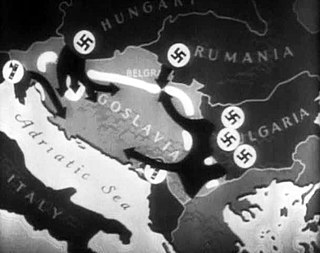
Operation Compass was the first large British military operation of the Western Desert Campaign (1940–1943) during the Second World War. British Empire forces attacked Italian forces of the 10th Army in western Egypt and Cyrenaica, the eastern province of Libya, from December 1940 to February 1941.

The Italian Army is the land-based component of the Italian Armed Forces. The army's history dates back to the Italian unification in the 1850s and 1860s. The army fought in colonial engagements in China, Libya, Northern Italy against the Austro-Hungarian Empire during World War I, Abyssinia before World War II and in World War II in Albania, Balkans, North Africa, the Soviet Union, and Italy itself. During the Cold War, the army prepared itself to defend against a Warsaw Pact invasion from the east. Since the end of the Cold War, the army has seen extensive peacekeeping service and combat in Afghanistan and Iraq. Its best-known combat vehicles are the Dardo infantry fighting vehicle, the Centauro tank destroyer and the Ariete tank and among its aircraft the Mangusta attack helicopter, recently deployed in UN missions. The headquarters of the Army General Staff are located in Rome opposite the Quirinal Palace, where the president of Italy resides. The army is an all-volunteer force of active-duty personnel.
The 10th Army was a field army of the Royal Italian Army, which fought in World War I and in Italian North Africa during World War II.

Savari was the designation given to the regular Libyan cavalry regiments of the Italian colonial army in Tripolitania and Cyrenaica. The word "savari" was derived from a Persian term for "horsemen" (Savārān).

The 10th Armoured Division was an armoured formation of division-size of the British Army, raised during the Second World War and was active from 1941–1944 and after the war from 1956–1957. It was formed from the 1st Cavalry Division, a 1st Line Yeomanry unit of the Territorial Army (TA) which had previously been serving in Palestine. The division was converted from cavalry to armour and redesignated from 1 August 1941.
The Italian order of battle for the Second Italo-Ethiopian War on 8 October 1935. The Ethiopian order of battle is listed separately.

The Frontier Wire was a 271 km (168 mi) obstacle in Italian Libya, along the length of the border of British-held Egypt, running from El Ramleh, in the Gulf of Sollum south to Jaghbub parallel to the 25th meridian east, the Libya–Egypt and Libya–Sudan borders. The frontier wire and its line of covering forts was built by the Italians during the Second Italo-Senussi War (1923–1931), as a defensive system to contain the Senussi population, who crossed from Egypt during their resistance against Italian colonisers.
The Order of battle of the East African campaign shows the ground forces of both sides in East Africa on the date that the Italians declared war on Britain and France, 10 June 1940 and for the British and Commonwealth forces involved in the 1941 offensive.

This article is about the Royal Italian Army which participated in the Second World War. The Royal Italian Army was reformed in 1861 and existed until 1946. The Royal Army started with the unification of Italy (Risorgimento) and the formation of the Kingdom of Italy. It ended with the dissolution of the monarchy. The Royal Army was preceded by the individual armies of the independent Italian states and was followed by the Italian Army of the Italian Republic.

The Paratroopers Brigade "Folgore" is an airborne brigade of the Italian Army. Its core units are three battalions of paratroopers (paracadutisti). The name "Folgore" is Italian for lightning. The Folgore is one of three light infantry brigades of the Italian Army. While the Folgore specializes in parachute operations its sister brigade in the Division "Vittorio Veneto" the Airmobile Brigade Friuli specializes in helicopter assault operations. The Folgore and its units are based in Tuscany, Veneto and Lazio.

Italian Libya was a colony of the Kingdom of Italy located in North Africa, in what is now modern Libya, between 1934 and 1943. It was formed from the unification of the colonies of Italian Cyrenaica and Italian Tripolitania, which had been Italian possessions since 1911.

The Italian invasion of Egypt was an offensive in the Second World War, against British, Commonwealth and Free French forces in the Kingdom of Egypt. The invasion by the Italian 10th Army ended border skirmishing on the frontier and began the Western Desert Campaign (1940–1943) proper. The Italian strategy was to advance from Libya along the Egyptian coast to seize the Suez Canal. After numerous delays, the scope of the offensive was reduced to an advance as far as Sidi Barrani and the engagement of any British forces in the area.

The Royal Corps Of Eritrean Colonial Troops were indigenous soldiers from Eritrea, who were enrolled as askaris in the Royal Corps of Colonial Troops of the Royal Italian Army during the period 1889–1941.

The Cacciatori d'Africa were Italian light infantry and mounted infantry units raised for colonial service in Africa. Cacciatori units later served in Somalia, Eritrea, Tripolitania and Cyrenaica for the Italian colonial empire. Partially mechanised in the early 1920s, the Cacciatori d'Africa remained part of the Regio Corpo Truppe Coloniali until 1942.

Italian Spahis were light cavalry colonial troops of the Kingdom of Italy, raised in Italian Libya between 1912 and 1942.
The 1st Libyan Division was an infantry division of the Royal Italian Army during World War II. It was commanded by general Luigi Sibille. The division took part in the Italian invasion of Egypt and was destroyed during the Battle of Sidi Barrani.

The Royal Corps of Colonial Troops was a corps of the Italian Armed Forces, in which all the Italian colonial troops were grouped until the end of World War II in Africa.

The Axis order of battle for the invasion of Yugoslavia was made up of the various operational formations of the German Wehrmacht and Waffen-SS, Italian Armed Forces and Hungarian Armed Forces that participated in the invasion of Yugoslavia during World War II, commencing on 6 April 1941. It involved the German 2nd Army, with elements of the 12th Army and a panzer group combined with overwhelming Luftwaffe support. The eighteen German divisions included five panzer divisions, two motorised infantry divisions and two mountain divisions. The German force also included two well-equipped independent motorised regiments and was supported by over 800 aircraft. The Italian 2nd Army and 9th Army committed a total of 22 divisions, and the Royal Italian Air Force had over 650 aircraft available to support the invasion. The Hungarian 3rd Army also participated, with support from the Royal Hungarian Air Force.
The Battle of Misrata was fought between Italian and Turkish forces on 9 July 1912 during the Italo-Turkish War. The battle was fought for the control of the Tripolitanian town of Misrata, a major supply base for Turkish–Arab forces.
Armando Pescatori was an Italian general during World War II. Among Italy's most experienced generals in colonial warfare, he is noted for leading the 2nd Libyan Division also known as the "Pescatori Division".














